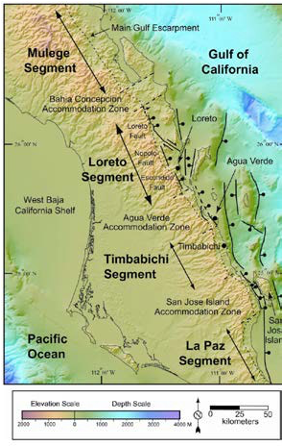
The Gulf of California is marginal sea that opened when the Baja California Peninsula was rifted off the western Mexican mainland about 6 million years ago (Fig. 1A). The Baja California margin of the Gulf of California is far more rugged than the mainland Mexico side, with far more islands adjacent to it (Fig. 1B), and is still tectonically active. This, together with excellent desert exposures, make it an ideal natural laboratory for studying continental rifting and associated volcanic activity. The Gulf of California is also a very productive margin, thanks to upwelling and tidal mixing of deep nutrient-rich water from the Pacific into the warm, stratified waters of the Gulf. This supports abundant fish, shrimp, sharks, sea lion and sea elephants, sea turtles, rays, and a wide variety of types of whales, as well as intertidal to shallow subtidal benthic marine invertebrates.


from 20 to 30 degrees C (upper panel) and surface chlorophyll ranging from 0.1 to 10 mg/m3(on log scale;
lower panel) in late October 2019.


